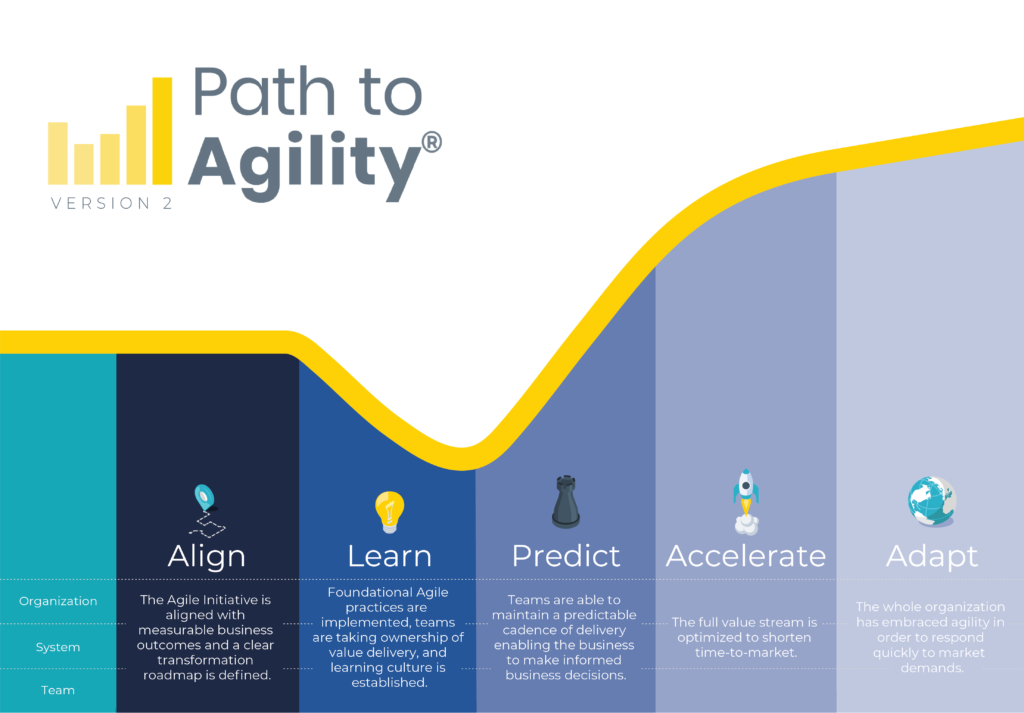
Value stream mapping is a common practice in the Agile space because it allows leaders and stakeholders to see where the flow of value delivery is slowing down and exposes opportunities to create better alignment across teams. However, it’s one of those practices commonly exercised after everyone is acutely aware that flow is slow or stagnant. Then it becomes a tool to help diagnose a problem (which is usually when Agile coaches are called in).
As an Enterprise Agile Coach, I have also used value stream mapping to help leaders view their organization through a different lens, which can help them anticipate problems likely to occur during their Agile Transformation. It’s a tool I use to sidestep a potential pitfall that can crater a transformation. Value stream mapping is even more critical if you are implementing SAFe (Scaled Agile Framework).
But before digging into this aspect, let’s do a quick overview.
Overview of Value Stream Mapping
Amazon is the fastest organization out there in terms of deploying software. According to this blog post, they are now at the point where they aim for full automation as they write new code. Ten years ago, it took them 16 days, but only 1 day of the 16 was actually writing code. What step(s) in their process accounted for the other 15?
This problem sheds light on one of the key aspects value stream mapping can help expose. A value stream map analyzes the steps and processes needed to deliver value. Most of the time, the trigger is an event like a check-out online. However, a trigger can also be an idea, such as a new feature for a product. In that case, the map helps analyze the lead time, how long it takes to get the new feature to customers. “Concept to cash” is a simple way of stating it.
While time and delays are the most common data you can glean from a value stream map, you can also learn where potential challenges might lie as it relates to the organization’s structure. (More on this when we talk about Agile Transformations and mapping value streams).
How do you do this? Involve leaders at the right level and at the right time
I have never had a value stream discussion that went smoothly and where we were able to see the whole “big picture” view without involving leaders at the VP or C-Suite level. If you are in the software space, it does not mean just dev leaders. It is important to have operations, product, developers and business leaders present as well. Depending on your industry, it might also be important to have a representative from sales and marketing. Once you have this team in the room (or Zoom), you can sketch out the flow at a high level.
Senior leaders can then identify who on their teams can provide more details about the processes and underlying systems. Meeting with the next level of leadership should be done at a separate time. You also need a neutral, third-party facilitator who can guide you through the process, ask the right questions, and keep the sessions productive.
When to identify and map value streams and how often
Certain events can trigger the need to do value stream mapping and analysis. It can be triggered by the addition of new teams, changes in company size, new tools or workflows, the addition of a new product, or during a M&A. If you are seeing and experiencing some red flags like delays, poor quality, and unhappy customers, it might be time to do some value stream mapping and analysis.
If your market is dynamic, then value stream mapping as an annual exercise (albeit at a smaller scale), might be a good practice. A big technology shift or a digital transformation can also be a trigger as it can affect the operational value streams.
Drastic changes in the market can also create new value streams if you can find them. For example, while COVID drastically impacted the value stream of in-person dining for restaurants, some restaurants created a new revenue stream for deliveries or invested heavily in the to-go revenue stream by adding online or mobile ordering capabilities.
Another common trigger for value stream mapping? Agile Transformations (but not for the reason you might expect).
Using Value Stream Mapping For Agile Transformation Success
We have discussed how the primary benefit of identifying value streams is to identify bottlenecks and opportunities to optimize flow…go faster. But before you can go faster, there are key capabilities and milestones that an organization needs to attain. Alignment is one of them, and identifying value streams at the start of the Agile transformation is a key step towards reaching that milestone.
Beginning your transformation without first getting aligned is like building a home on a shaky foundation. This is why “Align” is the first stage in our Agile transformation framework, the Path to Agility.

In this stage, we work with leaders to align the transformation initiative to measurable business outcomes and then define a transformation roadmap based on those outcomes. At the system level (teams of teams working together), we also help them understand the different ways value is delivered and the flow of value across the network of teams…sound familiar?
Once value streams have been identified, it is time to align the network of teams to them. Cue, scaling frameworks like SAFe®.
Value Streams and SAFe Agile Release Trains
A common way to construct organizations is to group people by similar skill sets or job functions. They then report to a common manager, who is typically an expert in that area and can understand the technical aspects of the jobs, hiring needs, etc. This group or department can be referred to as a silo. However, value isn’t created and delivered within a single silo, it necessarily flows across multiple silos. Connecting the various skills across silos, minimizing hand-offs and dependencies, and removing the resulting delays, allows value to flow faster across these groups.
A group of teams aligned to one value stream is what’s known in the Scaled Agile Framework as an ART (Agile Release Train). If you do not have value streams clearly identified, you cannot form a functioning Agile Release Train, no matter how much training or coaching you do. We help leaders design ARTs according to the prioritized value streams first, then do the training and coaching support needed to make the ART run. I have seen organizations that simply add a list of people and teams to a spreadsheet and call it an ART, when in fact, the teams are not aligned to a common purpose. That’s like designing a sports car with no engine.
Value Stream Mapping Next Steps
As a leader, you know that doing analysis for the sake of analysis is a waste. However, if you are experiencing noticeable delays, quality issues, or if your organization is not even creating the right product, a value stream analysis might be a viable next step. If you know an Agile transformation is on the horizon, then make value stream mapping a key item on the backlog and get your leadership team excited about taking the time to understand how value really flows. The time invested will pay major dividends in the future.
When you’re done gathering data and analyzing your map, you should have a comprehensive understanding of the overall process, steps to delivery, and the delays and bottlenecks to flow. You should also have a better idea of what value means to your organization and thus better alignment across sales, operations, business, and delivery.
Identifying value streams is a key step and deliverable in our Leading the Path to Agility and our System Agility SAFe transformation services. Visit our SAFe transformation page to learn where and how it fits in the Path to Agility. Have you ever done a value stream analysis? What questions can we answer?
What’s Your Organizational Agility Score?
In less than an hour, you’ll get valuable insights into your organization so you can improve team performance and achieve your business goals faster.




